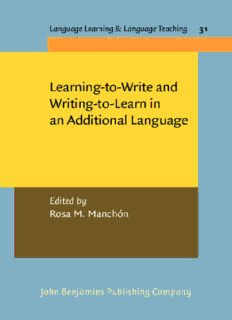Table Of ContentLearning-to-Write and Writing-to-Learn
in an Additional Language
Language Learning & Language Teaching (LL<)
The LL< monograph series publishes monographs, edited volumes and
text books on applied and methodological issues in the field of language
pedagogy. The focus of the series is on subjects such as classroom discourse
and interaction; language diversity in educational settings; bilingual
education; language testing and language assessment; teaching methods and
teaching performance; learning trajectories in second language acquisition;
and written language learning in educational settings.
For an overview of all books published in this series, please see
http://benjamins.com/catalog/lllt
Editors
Nina Spada Nelleke Van Deusen-Scholl
Ontario Institute for Studies in Education, Center for Language Study
University of Toronto Yale University
Volume 31
Learning-to-Write and Writing-to-Learn in an Additional Language
Edited by Rosa M. Manchón
Learning-to-Write and
Writing-to-Learn
in an Additional Language
Edited by
Rosa M. Manchón
University of Murcia
John Benjamins Publishing Company
Amsterdam / Philadelphia
TM The paper used in this publication meets the minimum requirements of
8
American National Standard for Information Sciences – Permanence of
Paper for Printed Library Materials, ansi z39.48-1984.
Library of Congress Cataloging-in-Publication Data
Learning-to-write and writing-to-learn in an additional language / edited by Rosa M.
Manchón.
p. cm. (Language Learning & Language Teaching, issn 1569-9471 ; v. 31)
Includes bibliographical references and index.
1. Second language acquisition. 2. Language and languages--Study and teaching. I.
Manchón, Rosa.
P118.2.L38 2011
418.0071--dc23 2011022622
isbn 978 90 272 1303 7 (Hb ; alk. paper)
isbn 978 90 272 1304 4 (Pb ; alk. paper)
isbn 978 90 272 8483 9 (Eb)
© 2011 – John Benjamins B.V.
No part of this book may be reproduced in any form, by print, photoprint, microfilm, or any
other means, without written permission from the publisher.
John Benjamins Publishing Co. · P.O. Box 36224 · 1020 me Amsterdam · The Netherlands
John Benjamins North America · P.O. Box 27519 · Philadelphia pa 19118-0519 · usa
� To Mia Victori,
In Memoriam
Table of contents
Preface� ix
Alister Cumming
Introduction
chapter�1
Situating�the�learning-to-write�and�writing-to-learn�dimensions��
of�L2�writing� 3
Rosa M. Manchón
Part I. Learning-to-write and writing-to-learn: Mapping the terrain
chapter�2
Learning�to�write:�Issues�in�theory,�research,�and�pedagogy� 17
Ken Hyland
chapter�3
Writing�to�learn�in�content�areas:�Research�insights� 37
Alan Hirvela
chapter�4
Writing�to�learn�the�language:�Issues�in�theory�and�research� 61
Rosa M. Manchón
Part II. Learning-to-write and writing-to-learn: Research insights
chapter�5
Learning�to�write�in�a�second�language:�Multilingual�graduates��
and�undergraduates�expanding�genre�repertories� 85
Ilona Leki
viii� Learning-to-Write�and�Writing-to-Learn�in�an�Additional�Language
chapter�6
Writing�to�learn�and�learning�to�write�by�shuttling�between�languages� 111
Suresh Canagarajah
chapter�7
Beyond�writing�as�language�learning�or�content�learning:��
Construing�foreign�language�writing�as�meaning-making�� 133
Heidi Byrnes
chapter�8
The�language�learning�potential�of�form-focused�feedback�on�writing:��
Students’�and�teachers’�perceptions� 159
Fiona Hyland
chapter�9
Writing�to�learn�in�FL�contexts:�Exploring�learners’�perceptions��
of�the�language�learning�potential�of�L2�writing� 181
Rosa M. Manchón and Julio Roca de Larios
chapter�10
Exploring�the�learning�potential�of�writing�development��
in�heritage�language�education� 209
John Hedgcock and Natalie Lefkowitz
Conclusion
chapter�11
Reflections�on�the�learning-to-write�and�writing-to-learn��
dimensions�of�second�language�writing� 237
Lourdes Ortega
Contributors’�biodata�� 251
Authors�index� 255
Thematic�index� 259
Preface
Alister�Cumming�
University�of�Toronto
Inquiry�into�writing�in�second�or�foreign�languages�has�always�involved�–�and�
may�even�be�defined�by�–�dialogues�among�diverse�interests�and�contrary�as-
sumptions.�Studies�of�writing,�composition,�or�rhetoric�have�tended�to�assume�
that�a�single�language�(often,�English)�is�constant,�but�studies�of�writing�in�second�
or�foreign�languages�(L2�writing)�complicate�this�assumption,�demonstrating�how�
language�and�cultural�variability�and�change�are�increasingly�the�norms�around�
the�world,�particularly�in�academic�and�work�situations.�Studies�of�second�lan-
guage�acquisition,�in�turn,�have�tended�to�assume�that�oral�communication�is�the�
standard�medium�to�evaluate�learners’�language�development,�but�studies�of�L2�
writing�complicate�this�assumption,�showing�how�writing�can�be�a�more�valued�
ability�(than�oral�proficiency)�in,�for�example,�classroom�or�academic�contexts,�
or�how�L2�learners�past�the�age�of�childhood�use�literate�resources�effectively�and�
integrally�in�ways�that�are�not�possible�in�the�early�acquisition�of�a�first�language.�
These�kinds�of�contrary�dialogues�tend�to�be�embraced�and�enacted�by�the�
practicing�educators,�programs,�and�curricula�that�draw�eclectically�on�an�array�
of�pedagogical�resources,�approaches,�and�concepts�to�guide�the�teaching�of�L2�
writing�(Leki,�Cumming�&�Silva�2008).�Over�the�past�few�decades,�the�extent�
of�activity�focused�on�L2�writing�has�increased�enormously,�following�from�in-
creased�international�mobility�and�communications,�such�that�studies�of�L2�
writing�have�become�institutionalized�in�many�educational�programs,�through�
scholarly�and�professional�associations�and�publications,�and�in�the�form�of�cer-
tification�for�teachers�and�basic�requirements�for�advanced�research�degrees�and�
scholarly�investigations.�An�inevitable�consequence�of�this�increased�activity�and�
institutionalization�is�serious�deliberation�over�key�concepts�as�well�as�systematic�
research�into�their�fundamental�nature.�
The�present�book�brings�together�and�evaluates�one�of�these�central�dialogues�
about�the�nature�of�L2�writing.�Contributors�address�the�fundamental�and�intrigu-
ing�paradox�that�L2�writing�is�not�only�an�ability�to�acquire,�teach,�and�assess�–�as�
is�conventionally�assumed�–�but�L2�writing�is�also�a�means,�context,�and�basis�for�
Description:This book is a pioneer attempt to bridge the gap between the fields of second language acquisition (SLA) and second and foreign language (L2) writing. Its ultimate aim is to advance our understanding of written language learning by compiling a collection of theoretical meta-reflections and empirical

